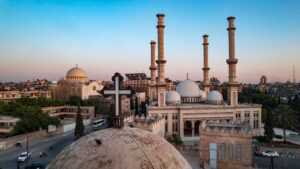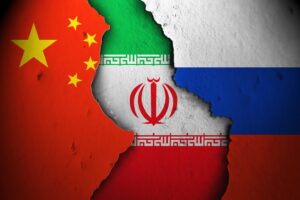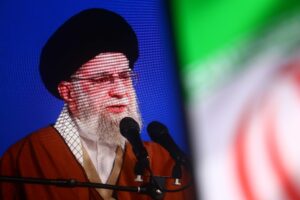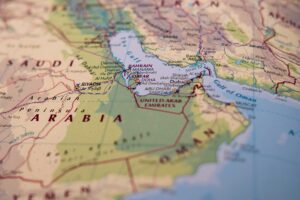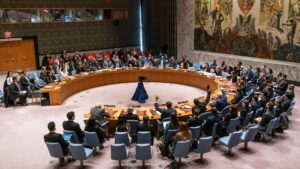Abridged speech by Dr. Nina Ansary for the Cambridge Middle East and North Africa Forum Women’s Leadership Initiative (WLI) speaker series commemorating International Women’s Day and Women’s History Month – Gonville and Caius College, University of Cambridge –15th March 2024
I was born in pre-revolution Iran during a relatively liberal period when women were given a myriad of rights and opportunities and achieved the highest levels of emancipation in the Middle East. I left Iran with my family at the cusp of the 1979 Islamic Revolution and have not returned since. As a young girl living in the capital city of Tehran, I was extremely close to both my grandmothers and at the time, took at face value the fact that one of my grandmothers was a devout woman who never left home without wearing her headscarf, and the other was a Western-educated progressive-minded woman. Yet both women were forces to be reckoned with and by no means subservient. However, it was not until decades after the revolution, when I was in the midst of my academic journey into the history of women’s rights in Iran, that I began to reflect on how my grandmothers personified very different lifestyles and beliefs. It was only then that I came to realize that women from disparate backgrounds in Iran have more in common than is widely assumed – that of a woman’s right to determine her own destiny, including the essential fact that attire does not and should not define any woman if it is by choice and not mandatory. Much like my two grandmothers, women in Iran have different perspectives, yet they are united in the desire to be free to follow their own path.
The historical narrative of the “woman question” in Iran is an intricate labyrinth. It is not a story that can be accurately recounted by portraying women as “oppressed” or “liberated’ during a particular historical period. The audacious history of women in Iran is complex, nuanced, with unexpected twists and turns, gains and losses, triumphs and defeats. In fact, when assessing the history of women in Iran, the inconvenient truths that arise are striking: For example, the Islamic Revolution that was explicitly antagonistic to the modernizing initiatives of the Pahlavi monarchy gave rise to a flourishing of powerful female voices, despite eradication of numerous emancipatory measures which afforded women rights and opportunities after centuries of patriarchal decrees and an inferior status. At the same time, the seeds of change planted during the Pahlavi era continued to benefit women and girls despite abolition of liberating policies and laws by the Islamic regime.
In the decades following the revolution, women in Iran have courageously battled the regime to regain their rights. But that landscape significantly shifted in the aftermath of the horrific murder in police custody of 22-year-old Kurdish-Iranian woman Mahsa Jina Amini on September 16th, 2022, igniting the Woman Life Freedom movement in Iran – a movement which became the biggest existential threat to the survival of the Islamic Republic in its 45-year history – a history tainted by egregious human rights violations, gender apartheid, corruption, persecution of religious and ethnic minorities, economic devastation and much more. In many ways, the Woman. Life. Freedom. movement was emblematic of a paradigm shift that touched every corner of Iranian society and had ripple effects into the diaspora and the global community – a seismic shift encompassing university students, school children, professors, journalists, activists, religious and ethnic minorities, factory workers, artists and countless other sectors. More importantly, a monumental shift occurred among the country’s youth, including the complete erosion of fear among a generation willing to sacrifice for freedom. Eighteen months later, the momentum of this movement cannot be extinguished and continues with courageous, powerful and symbolic acts of civil disobedience by women and girls despite violence, brutality and surge in repression by regime authorities. Their strength, resilience and determination are not only commendable but awe-inspiring and I, like many Iranians, am hopeful and have faith that they will succeed in changing the course of history in our homeland.
There may be a common tendency to believe that meaningful progress occurs only in the present tense, that efforts to improve society are stronger now than in our grandparents’ or great-grandparents’ era. Fact is, historically, women in Iran have always been part of national uprisings but this time, they are fearlessly leading them.
Prior to the 7th century Arab invasion and subsequent conversion to Islam, Iran was in many ways more progressive than some 21st century societies.
Securing women’s rights and the freedom to forge one’s own path is not a cause born in post-revolution Iran. Like women in most parts of the world, the women of Iran have been struggling for centuries for equal rights and the opportunity to realize their full potential. Their indomitable spirit and insistent calls have echoed throughout the annals of history. And while there have been periods when they were relatively free to determine their own lives, those moments have been few and far between. Acknowledging the historical roots of the women’s movement in Iran only serves to strengthen and inspire. Prior to the 7th century Arab invasion and subsequent conversion to Islam, Iran was in many ways more progressive than some 21st century societies. The First Persian Empire, also known as the Achaemenid Empire, was founded in the 6th century BC by Cyrus the Great. During this time, the Zoroastrian faith was the predominant ideology and reflected a clear belief in the equality of men and women. Women in this era were afforded similar rights and privileges to those of their male counterparts. Women were active in many professions and were permitted to assume leadership roles, and were part of a social system that accepted the authority and independence of women. They enjoyed payment equity with men and were eligible for “maternity leave” and received equitable treatment relative to men in inheritance. They served as high-ranking military commanders – Pantea Arteshbod (559 BC) was one of the greatest Persian commanders during the reign of Cyrus the Great. She played an important role in maintaining law and order in Babylonia after the conquest of the Neo-Babylonian Empire in 547 BC by Cyrus the Great. In Sassanian times, Apranik (AD 632) served as a high-ranking commander of the army and tirelessly fought to defend her nation against outside aggressors. A legend in her own right, Apranik’s motto was “No retreat, no surrender.” Women also held influential positions. One such individual was a successful landowner in 448 BC named Irdabama who oversaw a flourishing wine and grain business and employed a large workforce.
With the Arab invasion in the 7th century, egalitarianism was significantly transformed and conversion to Islam, which took many years, severely restricted women’s roles in both the public and private sphere. The gradual decline of Zoroastrianism and the eventual infusion of Islam into the fabric of Iranian society meant substantial changes in the everyday lives of women, including laws dictating their seclusion and subservience. In the centuries that followed, a handful of audacious women began to courageously go against the tide of patriarchy, gradually planting the seeds for change by challenging the status quo. One of the earliest activists to speak out against the unjust treatment of women in Iran was poet and Babi theologian Qurrat al-‘Ayn, also known as Tahirah (1817-1852). At a gathering in 1848 in support of the Babi religion that supported the equality of women, Tahirah boldly appeared unveiled. Tahirah was placed under house arrest and put to death in 1852. Considered the first suffrage martyr in Iran, Tahirah’s revolutionary spirit is hauntingly captured in her final words prior to her strangulation with a silk scarf:
“You can kill me as soon as you like, but you cannot stop the emancipation of women.”
One of the early pioneers of women’s rights in Iran was Bibi Khanum Astarabadi (1858-1921), who in 1895 wrote The Vices of Men (Ma’ayeb al Rejal), which was a critical response to the anonymously written The Education of Women (Ta’deed al-Nesvan). Considered to be the first declaration of women’s rights in the history of modern Iran, Astarabadi’s book was a penetrating yet satirical response to the anonymous piece advocating for the slavish subservience of women. A highly regarded figure of the early women’s movement, Bibi Khanum Astarabadi founded the School for Girls (Madreseh-ye-Dushizegan) in 1907 and ran the school from her home, providing formal education to young girls.
Another outspoken voice during this era was that of a woman raised in her father’s harem.
Taj al-Saltaneh (1884-1936), daughter of Qajar King Nasser al-Din Shah (1848-1896), wrote about the plight of women restrained by the bonds of tradition in her book Crowning Anguish: Memoirs of a Persian Princess From the Harem to Modernity. Despite her life of privilege, Taj expressed how she would rather be dead than alive and shrouded in black:
“Alas Persian women have been set aside from humankind and placed together with cattle and beasts. The lives of Persian women consist of two things: the black and the white. When they step outdoors to take a walk, they are frightful images of mourning in black. When they die, they are shrouded in white.”
The voices and actions of such pioneering women signaled early signs of opposition to an imposed social order that deprived women of a formal education, political participation and their overall freedom. During this era, a handful of women began to acknowledge that education was the key to expanded opportunities and that educating girls was paramount in combating women’s oppression and an essential ingredient if women were to succeed in breaking through the barriers of patriarchy. These women opened schools for girls and published magazines advocating for women’s participation in society. They even founded women’s societies (anjomans) to address their second-class status. They tirelessly campaigned for reform and openly condemned harmful practices such as early marriage and forced veiling. Such brazen assertions prompted riots, threats and at times even imprisonment. Yet these women remained undeterred despite hostility and severe backlash from the clerical establishment who wielded significant authority at the time based on a system of governance based on clergy-state alliance. During this time, their bold activism even extended to the political arena when women took it upon themselves to protest the Tobacco Concession granted to Great Britain by the monarchy and in fact were instrumental in its repeal. In the early 20th century, women took part in the Constitutional Revolution of 1906 which sought to break Iran free from foreign ownership of its resources.
One historical account written by Morgan Shuster, the American official appointed Treasurer General of Iran in 1911, testifies to women’s brave activism and dramatic role during the constitutional struggle:
“Out of their walled courtyard and harems marched three hundred of the weaker sex… clad in their plain black robes. Many held pistols under their skirts or in the folds of their sleeves. Straight to the Majlis (Parliament) they went and gathered there and demanded of the president that he admit them all. The president consented to receive a delegation of them. In his reception hall they confronted him, and lest he and his colleagues should doubt their meaning, these cloistered mothers, wives and daughters exhibited threateningly their revolvers, tore aside their veils, and confessed their decision to kill their own husbands and sons, and leave behind their own bodies, if the deputies wavered in their duty to uphold the liberty and dignity of the Persian people and nation.”
However, despite the inaugural calls for reform, the inferior status of women continued to be enshrined in the 1906 Constitution, which classified the female population under the same banner as “fraudulent, bankrupt beggars and all who seek their living in a disreputable way.” In 1911, the Speaker of the House, justified this reprehensible decree in the following way:
“The reason for excluding women is that God has not given them the capacity for taking part in politics. They are the weaker sex and do not have the power of judgement that men have.”
The era of Reza Shah and his son and successor, Mohammad Reza Shah Pahlavi, undoubtedly represented a giant leap forward, not just for women but for Iranian society.
With the coup d’etat of 1921, a relatively unknown commander of the Persian Cossack Brigade established the Pahlavi Monarchy. The era of Reza Shah and his son and successor, Mohammad Reza Shah Pahlavi, undoubtedly represented a giant leap forward, not just for women but for Iranian society. It was an era which put an end to centuries of clergy-state alliance. It was an era which replaced religious law codes with legal codes based on European models. It was an era which ushered in western education, modern dress, increase in the minimum age of marriage, as well as rights and opportunities including the Family Protection Act of 1967 and 1975, which meant increased autonomy for women, including the removal of restrictions in marriage, divorce and child custody matters, a complete ban on polygamy, the enfranchisement of women, and much more. The Pahlavi’s were determined to modernize Iran, to make it prosperous and to bring it into the 20th century and a huge part of this endeavor entailed releasing women from the shackles of patriarchy. In assessing these noble, profound and drastic overnight changes, historians maintain that many of the Pahlavi era policies were essentially a case of too much too soon. Meaning the rapid westernization which took place over the fifty plus years of their reign did not exactly benefit all women in the same manner and in fact had unintended consequences, particularly for those from religious and/or conservative backgrounds, largely unfamiliar with and struggling to adapt to an overnight shift towards a modern society. This was in direct contrast to women from primarily urban areas who welcomed and embraced these changes. It is the contention of analysts and historians that the cultural shift during this time was too precipitous and excessively focused on westernizing the society rather than giving more consideration to the cultural context into which the Pahlavi policies were incorporated. In her memoir Faces in the Mirror, the Shah’s twin sister, Princess Ashraf Pahlavi, a leading advocate of women’s rights in Iran, spoke about the complexities and challenges of transforming centuries of an entrenched way of life:
“It is obvious, and it became clear… that no ruler can legislate a social revolution. He can implement the outward form of social change, but he cannot legislate change in the minds of the people. Stable and lasting change has to evolve slowly and gradually over a period of many generations. Women for that matter, were not ready for the unknowns of a new social order… What signaled the beginning of the end, was the radical modernization program, which virtually effected every aspect of Iranian life, including the sweeping emancipation of women, which moved 13 centuries in the course of three decades.”
She further concludes that these swift, far-reaching changes, led some Iranians, including women to see “all modernization as a sacrifice of old values in exchange for those of the decadent West.”
While the regime hailed women as custodians of the private sphere, it simultaneously defrauded them through a plethora of archaic decrees depriving them of their basic rights, including areas related to marriage, divorce and child custody.
The 1979 Islamic Revolution spearheaded by Ayatollah Ruhollah Khomeini ushered in a theocracy that dismantled the progressive agenda of the Pahlavi era and instituted a constitution that stipulated governance according to the precepts of Sharia Law. Unquestionably, the enormous impact of this seismic upheaval was reflected in the overall status of women, who once again became entangled in a clerical doctrine justifying their inferior position via religious will. While the regime hailed women as custodians of the private sphere, it simultaneously defrauded them through a plethora of archaic decrees depriving them of their basic rights, including areas related to marriage, divorce and child custody. These included the abolition of the Family Protection Laws, reduction in the minimum age of marriage, the Islamic Retribution Laws stipulating that a woman’s life is worth half that of a man’s, as is her share of inheritance and testimony in a court of law. Additional laws depriving women of their basic rights, including the right to become a judge or run for president were part and parcel of an agenda to keep the female population at large shrouded in restrictions – a fate further sealed in the Islamic Constitution and Civil Code. There are few countries in the world in which women have experienced such sudden, shocking and drastic overnight changes. Iran is one of them.
Which brings me to the most baffling part of the Islamic Revolution – a revolution led by a misogynist cleric who dismantled and eradicated the myriad of rights and opportunities given to women: The fact that women, including those who had benefitted from the emancipatory decrees of the Pahlavi era, were initially some of Khomeini’s biggest supporters. Women like Nobel Laureate Shirin Ebadi. Ebadi, who was one of the first women in Iran to become a judge during the reign of Mohammad Reza Shah, nevertheless supported the revolutionary movement.
In her memoir, Ebadi explains her initial attraction, and that of many other women to Khomeini:
“Faith occupied a central role in our middle-class lives. Who did I have more in common with at the end: an opposition led by mullahs who spoke in tones familiar to ordinary Iranians or the gilded court of the Shah… It did not seem so alarming that the mullahs should take the lead. As the days went by, the fervor touched everyone around me and we all looked for ways to participate.”
Princess Ashraf Pahlavi additionally sheds light on Shirin Ebadi’s characterization of Iranian society during that era and the participation of women who came out strongly against a regime that helped free them from the bonds of oppression:
“Persia’s backward conditions were relics of social traditions… and the women for that matter were not ready to exchange this for the unknowns of a new social status…”
In reality, it took very little time after Khomeini came to power for women like Shirin Ebadi to become profoundly disillusioned. Stripped of her judgeship, as Islamic law prohibits women from serving as judges, she expressed her misconceptions about the revolution she had initially supported:
“It took scarcely a month for me to realize that, in fact, I had willingly and enthusiastically participated in my own demise. I was a woman, and this revolution demanded my defeat. My naivete astounds me.”
The educational foundation launched during Mohammad Reza Shah’s administration remained a surprising, yet crucial legacy.
Despite the daunting circumstances in the aftermath of the revolutionary upheaval, the seeds of change planted by the Pahlavi monarchy would continue to benefit Iranian women and girls despite the “best laid” plans of the Islamic regime to remove their imprints. In particular, the educational foundation launched during Mohammad Reza Shah’s administration remained a surprising, yet crucial legacy, particularly for the religious female population. Meaning that despite the Islamic Republic’s agenda aimed at eradicating all progressive measures and modernizing initiatives, in addition to undertaking a Cultural Revolution to “Islamicize” Iranian society, they massively failed to indoctrinate a whole generation of women to subscribe to their archaic and antiquated gender ideology. In fact, contrary to the expected outcome by regime authorities, the post-revolutionary years have given rise to a highly educated female population, with women outnumbering men in higher education. Women have excelled in practically every field despite the monumental obstacles and barriers – a testament to their courage, resilience and determination to shatter the status quo. Furthermore, throughout the decades they have spearheaded numerous initiatives and ground-breaking campaigns aimed at eradicating gender discriminatory laws. They have even boldly taken to reinterpreting passages in the Koran used by the regime to justify their inferior position. They have sacrificed at every turn and tried every which way to “bargain with patriarchy.” The difference is that today they are no longer willing to “bargain”. They are courageously leading the way for change, and they will not stop until they bring about the demise of this regime.
In a country ruled with the iron fist of Sharia Law, women and girls are at the forefront of change, risking everything for freedom, human rights and democracy. Today, women and girls in Iran have taken courage to another level, and are undoubtedly fueled and inspired by the legacy of young women like Mahsa Jina Amini, Nika Shakarami, Sarina Esmailzadeh, Hananeh Kia and countless others who have paid the ultimate price for the regime’s abusive forced veiling laws – the ultimate price for the right to peacefully protest – the ultimate price for the right to self-determination and the ultimate price for freedom.
At Mahsa Jina Amini’s funeral, her grandfather wrote the following on her tombstone:
“Mahsa, your name will be a symbol.”
Today, her name is indeed a symbol – a global symbol for freedom and her tragic and untimely death sparked the first women-led uprisings of our time, igniting an avalanche of grief and outrage in Iran as well as the international community.
In Iran, the struggle for women’s rights has been an arduous journey and yet within this journey, we find some of the most extraordinary stories of strength, resilience and hope. Theirs is a journey which resonates with the triumphs of the past, the harsh realities of the present and the promise of a brighter future.
In 1923, American missionary Clara Colliver Rice made the following prediction about women in Iran in her memoir Persian Women and Their Ways:
“It is difficult to find many bright spots on the lives of Persian women. Their liberty of movement, of action, and of speech is curtailed. In the prevailing social condition, they could not do anything unless they were helped by men. But some of the women maintain, and I agree with them, that the day will come when the men will ask for their help.”
Today, the daughters of Iran continue to shine and carry with them the legacy of Cyrus the Great. They are united in their desire for a future that upholds the values etched in the Cyrus Cylinder – recognized as the world’s first charter of human rights – a document that continues to resonate and inspire more than two and a half millennia later, and is in many ways reflected in the iconic Kurdish slogan of the Iran uprisings – Woman. Life. Freedom. – powerful words that are not only emblematic of a new dawn and a new chapter in Iran’s history but have spread globally as a sobering reminder that the pursuit of justice, human rights and equality are universal aspirations that transcend borders, politics and ideologies.







